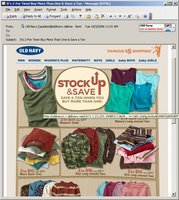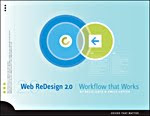Follow Up: Power of Persona
 Bit of a follow up here. In our last Experience Toolkit we talked about "The Power of Persona." That is, how using personas can foster a more tangible understanding of a target audience's needs, desires, pet peeves and behavior. Personas create "real life" scenarios that support customer dialog inside an organization, and rally teams to drive multi-channel development in a manner that results in a more cohesive customer experience. The Marketing Profs syndicated article got some good feedback, and I received a number of questions including those surrounding the application and creation of personas in the market today.
Bit of a follow up here. In our last Experience Toolkit we talked about "The Power of Persona." That is, how using personas can foster a more tangible understanding of a target audience's needs, desires, pet peeves and behavior. Personas create "real life" scenarios that support customer dialog inside an organization, and rally teams to drive multi-channel development in a manner that results in a more cohesive customer experience. The Marketing Profs syndicated article got some good feedback, and I received a number of questions including those surrounding the application and creation of personas in the market today. So here's a follow up with a few comments.
There are tons of great articles about he use of persona out on the web, and I highly recommend a search and read on the topic. One article you might want to check out is a presentation from Forrester Research on Personas as a Best Practice (slide show). There's also a great article from Advertising Age in June 2006 (PDF format) for your reference.
It's impossible to deny the emerging significance of personas in defining, designing and refining customer experience, product and interaction design. While many have embraced the value of persona use in interaction design (software/web), many organizations are now thinking bigger. It's about time.
We've already talked about Best Buy, which employs a deep use of personas in customer profiling, databases, store design. I'd love to see are some updates about the evolution of Best Buy profiling. On an inside track, I've learned that Jill is no longer the woman described in the Washington Post article mentioned above - she has morphed, and they've got new female profiles now. Whatever the case, it's obvious Best Buy is learning a lot at a time when competitors like Circuit City face some harsh business reality. Best Buy has invested in evolving its business model and they're reaping benefits in the form of growth.
Anecdotally, Best Buy's employees are also learning a lot about recognizing customers and realizing market opportunity, as well. One 20-something music department employee from a Best Buy store in Texas called his manager's attention to a key demographic being missed entirely in the store: the Mega Church attendee. Under the manager's direction, the employee conducted research and created a listing of Christian Music that he felt would boost music sales in the department. The manager took the recommendations to corporate HQ and gained permission to test the idea in the store. Within months, music sales increased in the music department by 15%. The program rolled out to other stores across the region shortly thereafter.
On a different note, I've followed some work that Organic has done with Chrysler this year. Working with a stage design firm, Organic developed "persona rooms" designed to inspire more customer-focused development of cars (and marketing programs) to Gen X customer base. The persona rooms allow Chrysler designers to work within the customer's personal space and absorb the interests, needs, desires and personality to inspire design direction. The rooms feature personal style, taste, products and musical taste and even go so far as to feature bulletin board updates and "My Space" pages for several of the personas they have developed. (You can read more about this in the article from Advertising Age June 2006 article (PDF format).
Looking at other applications for persona... I have a client who has used personas for the development of integrated campaigns and programs for several years. She is now looking at how to use personas to change the way she manages and structures teams inside her organization. As an executive marketer, she serves a diverse audience of technologists, product developers and other characters. She uses personas to help her staff understand the needs and drivers of these individuals to empower them to manage their "internal customers" more effectively. She also counsels her team on how to rally participants around shared goals that center on customer need and experience. In her words "it's a pain, and it takes more time. I'm still working out kinks all the time, but I gotta tell you, when you get the right team balance, the right customer focus and the the right programs to connect, the results are magic. We've only seen a hint at how this is going to pay off... and my staff recognizes the power of working this way, too."
There's no end to the companies that are using personas to develop multi-channel experiences. Consider Starbucks, is using personas to develop annual reports (among other things). Discover Card, which used personas to create marketing campaigns to various types of customers. Roche Pharmaceuticals, which used personas to create multi-channel campaigns targeted to women with osteoporosis, and Ann Taylor, which is using personas to focus targeting and retail design.
Ultimately, it's not enough just to develop a persona, or group of personas. That's the end, not the means. The goal of persona use is to develop a well defined, and easily articulated picture of the cusstomers we serve. We must iteratively use personas to benchmark and refine our view of the customer as much as we use them to refine and shape the architecture that supports customer experience. The lesson of it all: when we shape our organizations around a well defined knowledge of who we serve, we in turn empower our organizations to serve those customers well.
D'Oh - Old Navy Experience Hiccup
 We've talked a lot about the fundamentals of customer experience on this site. We've also talked about how operational issues cause customer experience compromise. Unfortunately, as most of us know, it's easy to miss the boat on these fronts.
We've talked a lot about the fundamentals of customer experience on this site. We've also talked about how operational issues cause customer experience compromise. Unfortunately, as most of us know, it's easy to miss the boat on these fronts. While I'm sure there's more to the story, I thought I'd share this potentially great example of these dynamics at play. I got this rather compelling email from Old Navy today:

About 10 minutes later, I decided to surf to Old Navy and save. I opened up the email and clicked - and got a 404 error. I then clicked five places of the email and got a "Server not responding" error. I checked my internet connection and clicked once more, where I got this page:

The message reads "We're updating our site to bring you a better shopping experience. Old Navy is temporarily closed for scheduled site maintenance..."
Planned site maintenance? In tandem with the release a large push email?
I'm sure there's more to the story than this, but it sounds like one of two things happened: Either 1) The development and marketing departmental silos aren't communicating well together in an effort to coordinate outbound marketing with planned site maintenance... or 2) perhaps Old Navy's site went down due to an overwhelming response to the email.
In the latter case, it appears Old Navy only has one error screen to use when the site goes down. It basically says "We're closed, and we planned this." That's a pretty rude message for a customer who was JUST invited shopping! If the site did go down (and hey - it happens) wouldn't it be better for Old Navy to have an alternative error message for non-planned outages that says something this:
"We're sorry - the site is temporarily unavailable. To compensate for your inconvenience, we'll give you an additional 10% off your next order. Just use this code when you check out: 123ERROR. Print this now and check back with us later to save even more! Thanks and apologies from your friends at Old Navy."
Better to recover those shoppers at a cost than have them forget to come back, right? Not so hard to do, either.
Based on my estimation, the site was down for about 2 hours ... It's back up now. I can't help but wonder how much this little snaffu cost Old Navy today?
Getting the fundamentals of experience right can't be overstated. It requires cross-departmental communication, coordination and scenario planning. When this doesn't happen, it wastes corporate energy, burns revenue and has the potential to seriously damage customer relationships. Of course, I'll go back to Old Navy... this is just a good "food for thought" example.
Subscribe to:
Posts (Atom)
FAVORITES
- On Trust & Influence
- Don't be Social Media Sharkbait
- The Social Media Engagement Continuum
- 10 Tips for Twitter Unmarketing
- Five Experience Funamentals
- Experience & Branding: The Three Word Rule
- Get Some Experience Healing!
- Discovering Customer Experience Pitfalls
- Not My Job: The CX Enemy
- Shoe Carnival: Watch Out for Carnies!
- Bathroom Usability
RECENT COMMENTS
SEARCH
LEIGH DURST

I’m Leigh Durst, a 20 year veteran in business, operations, customer strategy, ecommerce, digital & social media and marketing. Simply put, I’m a strategist that helps companies (start-up to blue chip) achieve business shift, create more compelling online and offline experiences. I also write, speak and teach about experience design and next-generation business. I’m a futurist, visionary, strategist, doer and connector with a passion for people and helping others. When I’m not on the road, you’ll find me in the San Francisco bay area, working, beaching it and hanging out with my family and dog.
Labels
advertising
air travel
bank experience
bathrooms
Best Practices
branding
brick and mortar retail
charlene li
Community
Content
Copy writing
cottonelle
customer centricity
customer experience
customer experience files
Customer Experience Leaders
customer experience management
customer experience pitfalls
customer experience; innovation;
Customer Relationship Management
customer research
CX
Defining Customer Experience Management
economy
Ethics
experience best practices
experience file
experience pitfalls
good customer experience
Group Think
Harassment
infrastructure
Innovation
life
marketing
marketng
motherhood
old navy
personal
Plagiarism
Plurk
privacy
reinvention
RESOURCES
restaurant experience
retail experience
security
Social Media
Social Media Expert
social networking
starbucks
stuck
target
toilet paper
trust agents
trust continuum
Twitter
usability best practices
user experience
user experience
UX
Web 2.0
Web Strategy
word-of-mouth


